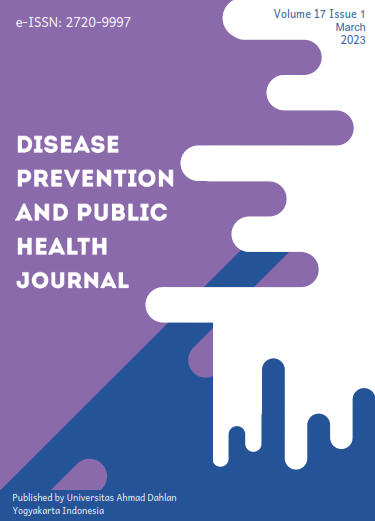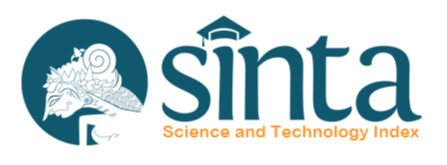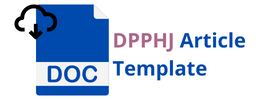Identification and Resistance Testing of Bacteria Causing Nosocomial Infections in Surgery Inpatient Rooms
DOI:
https://doi.org/10.12928/dpphj.v17i1.6875Keywords:
Infection, Nosocomial, Bacteria, Antibiotic ResistanceAbstract
Background: Nosocomial infections are the most common infections that occur when patients are under medical care in hospitals. The most common pathogenic bacteria that cause nosocomial infections are Staphylococcus aureus, Escherichia coli, Pseudomonas aeruginosa, Enterobacter spp, and Klebsiella pneumonia. One of the factors causing a nosocomial infection is the environment. The spread of nosocomial infections in dr. Doris Sylvanus can occur in the surgical ward environment. Therefore, it is necessary to study and know the identification of bacteria and knowing the pattern of antibiotic resistance of bacteria that cause nosocomial infections in the surgical inpatient ward of dr. Doris Sylvanus Hospital. Methods: This type of research used an observational method with a descriptive approach. The research at dr Doris Sylvanus Hospital. The population is dahlia room which consisted of floors, sheets, patient beds, tables, and door handles. Results: Bacterial identification was Staphylococcus aureus at 13.4% and Staphylococcus non-coagulase at 10%, also found Gram-negative bacteria suspected Salmonella sp. 3.3% and other bacteria at 73.3% The results of the Trimethoprim-sulfamethoxazole antibiotic resistance test on S. aureus bacteria had a sensitivity of 50% and Oxacillin had a sensitivity of 75%, while the Trimethoprim-sulfamethoxazole resistance test results on S. non-coagulase bacteria had a sensitivity of 66.7% and Oxacillin had a sensitivity of 100%. Conclusion: The Trimethoprim-sulfamethoxazole antibiotic resistance test on S. aureus bacteria has moderate sensitivity and the Oxacillin antibiotic has a fairly high sensitivity while on S. non-coagulase bacteria have a fairly high sensitivity and oxacillin antibiotics have high sensitivity.
References
Liu JY, Dickter JK. Nosocomial Infections: A History of Hospital-Acquired Infections. Gastrointest Endosc Clin N Am. 2020 Oct;30(4):637-652. doi: 10.1016/j.giec.2020.06.001. Epub 2020 Jul 30. PMID: 32891222.
Hapsar PA, Wahyuni UC, Mudjianto D. Knowledge of Surveillance Officers on Identification of Healthcare-associated Infections in Surabaya. J Berk Epidemiol 2018;6:130–8. https://doi.org/10.20473/jbe.v6i22018.130-138.
Suleyman G, Alangaden GJ. Nosocomial Fungal Infections: Epidemiology, Infection Control, and Prevention. Infect Dis Clin North Am. 2021 Dec;35(4):1027-1053. doi: 10.1016/j.idc.2021.08.002. PMID: 34752219.
Lemiech-Mirowska E, Kiersnowska ZM, Michałkiewicz M, Depta A, Marczak M. Nosocomial Infections as One of the Most Important Problems of Healthcare System. Ann Agric Environ Med. 2021 Sep 16;28(3):361-366. doi: 10.26444/aaem/122629. Epub 2020 Jun 5. PMID: 34558254.
Gill AAS, Singh S, Thapliyal N, Karpoormath R. Nanomaterial-Based Optical and Electrochemical Techniques For Detection of Methicillin-Resistant Staphylococcus aureus: A Review. Mikrochim Acta. 2019 Jan 16;186(2):114. doi: 10.1007/s00604-018-3186-7. PMID: 30648216.
Wismana WS. Description of Microbiological Air Quality in Operating Room and Health Complaint. J Kesehat Lingkung 2019;8:219–28. https://doi.org/http://dx.doi.org/10.20473/jkl.v8i2.2019.219-228Malo.
Vaiyapuri M, Joseph TC, Rao BM, Lalitha KV, Prasad MM. Methicillin-Resistant Staphylococcus aureus in Seafood: Prevalence, Laboratory Detection, Clonal Nature, and Control in Seafood Chain. J Food Sci. 2019 Dec;84(12):3341-3351. doi: 10.1111/1750-3841.14915. Epub 2019 Nov 26. PMID: 31769517.
Pang Z, Raudonis R, Glick BR, Lin TJ, Cheng Z. Antibiotic resistance in Pseudomonas aeruginosa: mechanisms and alternative therapeutic strategies. Biotechnol Adv. 2019 Jan-Feb;37(1):177-192. doi: 10.1016/j.biotechadv.2018.11.013. Epub 2018 Nov 27. PMID: 30500353.
Laborda P, Sanz-García F, Hernando-Amado S, Martínez JL. Pseudomonas aeruginosa: an antibiotic resilient pathogen with environmental origin. Curr Opin Microbiol. 2021 Dec;64:125-132. doi: 10.1016/j.mib.2021.09.010. Epub 2021 Oct 26. PMID: 34710741.
Nawan, Isnaeni Eddy B. Wasito. Antimicrobial Activity of Streptomyces sp. Isolated from Acidic Peatlands against Extended Spectrum Beta Lactamase (ESBL) producing Escherichia coli. Res J Pharm Tech 2020;13:1121–6. https://doi.org/10.5958/0974-360X.2020.00206.1.
Karaman R, Jubeh B, Breijyeh Z. Resistance of Gram-Positive Bacteria to Current Antibacterial Agents and Overcoming Approaches. Molecules. 2020 Jun 23;25(12):2888. doi: 10.3390/molecules25122888. PMID: 32586045; PMCID: PMC7356343.
Tarabichi S, Chisari E, Van Nest DS, Krueger CA, Parvizi J. Surgical Helmets Used During Total Joint Arthroplasty Harbor Common Pathogens: A Cautionary Note. J Arthroplasty. 2022 Aug;37(8):1636-1639. doi: 10.1016/j.arth.2022.03.066. Epub 2022 Mar 24. PMID: 35341923.
Garg SK. Antibiotic misuse during COVID-19 Pandemic: A Recipe for Disaster. Indian J Crit Care Med. 2021 Jun;25(6):617-619. doi: 10.5005/jp-journals-10071-23862. PMID: 34316138; PMCID: PMC8286398.
Chitungo I, Dzinamarira T, Nyazika TK, Herrera H, Musuka G, Murewanhema G. Inappropriate Antibiotic Use in Zimbabwe in the COVID-19 Era: A Perfect Recipe for Antimicrobial Resistance. Antibiotics (Basel). 2022 Feb 13;11(2):244. doi: 10.3390/antibiotics11020244. PMID: 35203846; PMCID: PMC8868384.
Kollef MH, Torres A, Shorr AF, Martin-Loeches I, Micek ST. Nosocomial Infection. Crit Care Med. 2021 Feb 1;49(2):169-187. doi: 10.1097/CCM.0000000000004783. PMID: 33438970.
Du Q, Zhang D, Hu W, Li X, Xia Q, Wen T, Jia H. Nosocomial Infection Of COVID 19: A New Challenge For Healthcare Professionals (Review). Int J Mol Med. 2021 Apr;47(4):31. doi: 10.3892/ijmm.2021.4864. Epub 2021 Feb 4. PMID: 33537803; PMCID: PMC7891837.
Dahiya S, Chhillar AK, Sharma N, Choudhary P, Punia A, Balhara M, Kaushik K, Parmar VS. Candida auris and Nosocomial Infection. Curr Drug Targets. 2020;21(4):365-373. doi: 10.2174/1389450120666190924155631. PMID: 31549952.
Luo K, Tang J, Qu Y, Yang X, Zhang L, Chen Z, Kuang L, Su M, Mu D. Nosocomial Infection By Klebsiella Pneumoniae Among Neonates: A Molecular Epidemiological Study. J Hosp Infect. 2021 Feb;108:174-180. doi: 10.1016/j.jhin.2020.11.028. Epub 2020 Dec 5. PMID: 33290814.
Liu JY, Dickter JK. Nosocomial Infections: A History of Hospital-Acquired Infections. Gastrointest Endosc Clin N Am. 2020 Oct;30(4):637-652. doi: 10.1016/j.giec.2020.06.001. Epub 2020 Jul 30. PMID: 32891222.
Bardi T, Pintado V, Gomez-Rojo M, Escudero-Sanchez R, Azzam Lopez A, Diez-Remesal Y, Martinez Castro N, Ruiz-Garbajosa P, Pestaña D. Nosocomial Infections Associated To COVID-19 In The Intensive Care Unit: Clinical Characteristics And Outcome. Eur J Clin Microbiol Infect Dis. 2021 Mar;40(3):495-502. doi: 10.1007/s10096-020-04142-w. Epub 2021 Jan 3. PMID: 33389263; PMCID: PMC7778834.
Vain NE. Nosocomial Respiratory Viral Infection in the Neonatal Intensive Care Unit. Am J Perinatol. 2020 Sep;37(S 02):S22-S25. doi: 10.1055/s-0040-1714081. Epub 2020 Sep 8. PMID: 32898879.
Li X, Wang L, Wang H, Hou X. Outcome and Clinical Characteristics of Nosocomial Infection in Adult Patients Undergoing Extracorporeal Membrane Oxygenation: A Systematic Review and Meta-Analysis. Front Public Health. 2022 Jun 24;10:857873. doi: 10.3389/fpubh.2022.857873. PMID: 35812481; PMCID: PMC9268548.
Su C, Zhang Z, Zhao X, Peng H, Hong Y, Huang L, Huang J, Yan X, Wu S, Bai Z. Changes in Prevalence Of Nosocomial Infection Pre- And Post-COVID-19 Pandemic from a tertiary Hospital in China. BMC Infect Dis. 2021 Jul 20;21(1):693. doi: 10.1186/s12879-021-06396-x. PMID: 34281515; PMCID: PMC8289622.
He Y, Chen J, Chen Y, Qian H. Effect of Operating Room Nursing Management on Nosocomial Infection in Orthopedic Surgery: A Meta-Analysis. J Healthc Eng. 2022 Feb 26;2022:4193932. doi: 10.1155/2022/4193932. PMID: 35256898; PMCID: PMC8898123.
Yu T, Zhang X, Wang Q, Zheng F, Wang L. Communication Openness And Nosocomial Infection Reporting: The Mediating Role Of Team Cohesion. BMC Health Serv Res. 2022 Nov 24;22(1):1416. doi: 10.1186/s12913-022-08646-3. PMID: 36434720; PMCID: PMC9701000.
Miura H, Taniguchi K, Narita K, Kawamura Y, Kozawa K, Muramatsu H, Takahashi Y, Ihira M, Yoshikawa T. Nosocomial Infection With Rotavirus Vaccine Strain In Paediatric Patients With Immunodeficiency. J Hosp Infect. 2022 Mar;121:9-13. doi: 10.1016/j.jhin.2021.12.009. Epub 2021 Dec 14. PMID: 34915052.
Alriyami M, Al Omari O, Al-Daken L, Alriyami T, Al Rashdi R, Al Shukaili S, Al-Alawi T, Al Qadire M. Assessing Knowledge Of Nosocomial Infection Among Omani Student Nurses: A Cross-Sectional Study. Br J Nurs. 2022 Jan 27;31(2):66-70. doi: 10.12968/bjon.2022.31.2.66. PMID: 35094542.
Sribnick EA, Hensley J, Moore-Clingenpeel M, Muszynski JA, Thakkar RK, Hall MW. Nosocomial Infection Following Severe Traumatic Injury in Children. Pediatr Crit Care Med. 2020 May;21(5):443-450. doi: 10.1097/PCC.0000000000002238. PMID: 32106190.
Nizam A, Nimaroff ML, Menzin AW, Goldberg GL, Miyara SJ, Molmenti E. Nosocomial COVID-19 Infection In Women Undergoing Elective Cesarean Delivery: A Prospective Cohort Study. Am J Obstet Gynecol MFM. 2022 Jan;4(1):100490. doi: 10.1016/j.ajogmf.2021.100490. Epub 2021 Sep 17. PMID: 34543753; PMCID: PMC8447544.
Lemiech-Mirowska E, Kiersnowska ZM, Michałkiewicz M, Depta A, Marczak M. Nosocomial Infections As One Of The Most Important Problems Of Healthcare System. Ann Agric Environ Med. 2021 Sep 16;28(3):361-366. doi: 10.26444/aaem/122629. Epub 2020 Jun 5. PMID: 34558254.
Downloads
Published
Issue
Section
License
Copyright (c) 2023 Universitas Ahmad Dahlan

This work is licensed under a Creative Commons Attribution-ShareAlike 4.0 International License.
Authors transfer the copyright and grant the Disease Prevention and Public Health Journal right of first publication with the work simultaneously licensed under a Creative Commons Attribution License (CC BY-SA 4.0) that allows others to share (copy and redistribute the material in any medium or format) and adapt (remix, transform, and build upon the material) the work for any purpose, even commercially with an acknowledgement of the work's authorship and initial publication in Disease Prevention and Public Health Journal. Authors are able to enter into separate, additional contractual arrangements for the non-exclusive distribution of the journal's published version of the work (e.g., post it to an institutional repository or publish it in a book), with an acknowledgement of its initial publication in Disease Prevention and Public Health Journal. Authors are permitted and encouraged to post their work online (e.g., in institutional repositories or on their website) prior to and during the submission process, as it can lead to productive exchanges, as well as earlier and greater citation of published work (See The Effect of Open Access).

This work is licensed under a Creative Commons Attribution-ShareAlike 4.0 International License.







